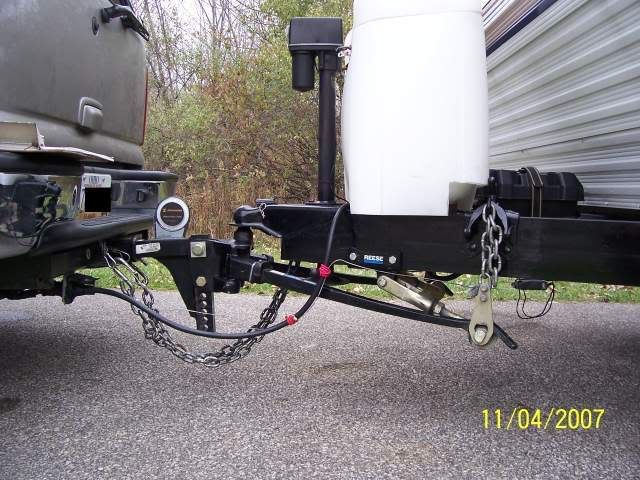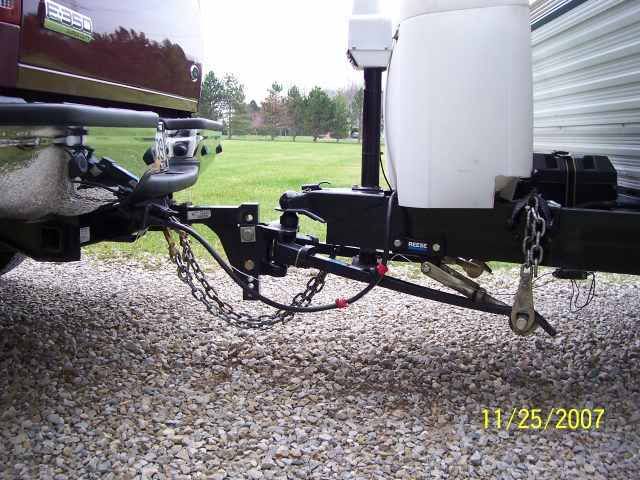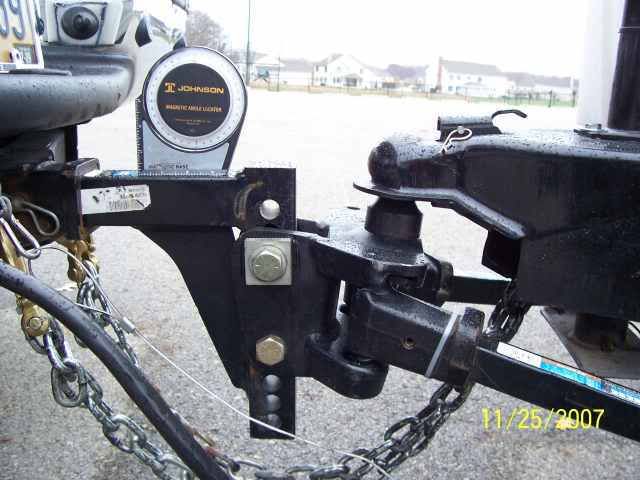Ron Gratz wrote:
We had three days of rain here in the twin cities of Marinette, WI, and Menominee, MI.
Thanks Ron, We had a good Memorial day. Here in Central OH it was “full on” summer… 90 to 92 deg F all 3 days. Glad we had the AC in the camper to escape the heat and be able to sleep at least.
Ron Gratz wrote:
Receiver torsional stiffness does not enter into the relationship between WD spring force and load transfer.
JBarca wrote:
---When you do reach the WD spring force to be the same on a less efficient receiver after over adjusting the hitch, then yes the WD on the TV will be the same.---
Ron Gratz wrote:
I think we're saying the same thing -- if the WD spring force is the same, the load transfer will be the same -- regardless of receiver torsional stiffness.
I think we also agree that, if receiver torsional stiffness is sufficiently low, physical restrictions on ball mount tilt and/or lift chain length might limit WD bar force.
However, 100% of the torque which is generated by the WD bars will be transmitted to the tow vehicle via the receiver. It has nowhere else to go. Nothing is "consumed" or "eaten up" by the receiver.
Yes, we do agree. Once the WD bars gets loaded up enough, the weight will move. The words "consumed" or "eaten up" by the receiver I believe were used to describe what can and has occurred on some OEM receivers when excess flex is observed.
When I had my 2003 K2500 Suburban I had a level of what I would state is “receiver inefficiency” occurring. This may have been the beginning of realizing this vintage TV with the torsion bar front end suspension is not going to squat equal and GM did not want it too either. Just in 2003 they never put that in the owner’s manual and a 39 page post on RV.net was born…. By 2004 GM did list in the manual to not over compress the front end.
In my case I was up against a level of receiver to frame flex and possibly a level of excess receiver twist. I was losing the ability to transfer the hitch WD forces to the front of the truck. I did change the receiver to a Putnam XDR which had different adjusting attributes.
I did experience what I would describe is a large amount “receiver inefficiency” on my buddies 2002 Yukon (shorty WB Yukon). He had a Draw-tite hitch with the DC and he came to the house and we setup the hitch in my yard. He tried on his own to get this right but was having trouble as the WD settings where not responding like others have had.
He had a Travel-Star camper with an approx. 850# TW as measured by my Sherline tongue scale IRRC. This is now maybe 6 years ago, maybe more. He had 1,200# WD bars. We totally reset the hitch so the DC would not be in a binding condition in turns then started to adjust the head tilt to gain proper WD on the TV which in this case was to return the front axle to unhitched fender height.
His receiver was not responding like others I had adjusted. A washer of head tilt to the rear would result in not much to almost no movement on the front of the truck. It took almost 3 washers worth of tilt to get the front to change much. Granted in this case I did not have the dial indicator out measuring fender heights, we were using a tape measure. There was a zone of very high “receiver inefficiency” were hitch head tilt movements would not yield fender changes on the front of the TV to expected results. Once we started approaching 4 to 5 more washers we had an abrupt amount of movement.
On this setup once all washers that the head tilt pin could accept and an additional chain link we over drove the front end beyond unhitched and had to back off. This soft 1500 suspension you could overdrive the front end much quicker than the 2500.
When we were all done and the TT leveled out, the front was above 1/8 to 3/16” of unhitched height I stepped back and looked at the hitch head. WOW… to my surprise we had used up all of the head tilt and the hitch shank was very high up in the air. This Draw-tite head of that era had approx. 12 degrees of rear tilt with full washers. The head was tilted to the rear approx. 10 to 12 degrees with the shank close to that far above unhitched. That is a lot of rear head tilt and much more than normally needed to get a WD hitch to adjust properly with strong WD bars and a lighter TW.
In this case the receiver was rated at 1,500# in WD mode against an 850# loaded TW using 1,200# WD bars. That combo should not of given the end results it did. I told him this receiver is not responding correct, we have used almost all of the hitch settings and it still is not right. He took it home, ordered a Putnam Class 4 had his dealer installed it for him and even the dealer was shocked. The system adjusted out like it should with the receiver change.
I wish we had more time, I would of really liked to study that receiver to see where the loss of torsional twist was going. The end result was the pin box to the receiver tube and the receiver tube to the frame brackets rotated further then normally observed even on my K2500 original Burb receiver with a 1,200# TW which was the same series receiver.
Ron Gratz wrote:
As a side note -- the VESC V-5 Regulation and the corresponding SAE Standard indicate that a rotation of up to 5 degrees is acceptable.
Ron
Yes I know you found this spec a long time ago and was really good info. I would have to go back and find it to see if they state where the 5 degrees starts. I have found when a loaded TW is in the 900 to 1,200# range that the dead weight on the ball can rotate the pin box down approx. 5 degrees from unhitched position. Once WD is adjusted to return the TV front axle to unhitched height the pin box can be rotated up 2 to 3 degrees from the unhitched position. See here, NOTE, this is a 1,200# TW, using 1,200# WD bars, 2003 K2500 Burb, Putnam XDR receiver rated at 1,700# in WD mode.

Now see the same camper, same loaded 1,200# TW, same 1,200# WD bars, 2005 F350, Ford OEM receiver rated at 1,250# in WD mode.


The F350 OEM Super duty receiver has a tighter shank to pin box fit then the Putnam XDR did which made the XDR need more tilt.
I know that the suspensions are different between the K2500 Burb and the F350 as well as the TV WB. However the receiver ratings where a lot different too. I have not yet found a relationship between TW WD mode rating to when a receiver exhibits this high inefficiency problem. Some have lots of rating and the TW is low in comparison while some are at the high end of the ratings and work great.
Your statement about;
Ron Gratz wrote:
However, 100% of the torque which is generated by the WD bars will be transmitted to the tow vehicle via the receiver. It has nowhere else to go.
Yes it is true where 100% of the torque is going into the receiver, however it is not always being reflected at the front wheels of the TV. It is being lost in the process. The connection between the hitch shank and the front of the TV front end has more flex in some setups then others. Once the lost motion is accounted for the WD adjustments start showing up at the front axle, hopefully before you run out of hitch adjustment.
When some folks talk about "consumed" or "eaten up" by the receiver, “I believe” they are referring to lost motion or excessive rotation in the receiver system. Some GM’s from year 2000 to 2006, some Toyota 750# WD rated receivers on PU's and some F150's have experienced this effect to name a few I have run across. You can generally spot the issue by the hitch shank pointing up at a very high angle, 5 plus degrees from unhitched, trying to get the TV front end close to unhitched height.
This lost motion or excessive rotation in the receiver system may be in spec however you may also have a WD hitch that cannot tolerate it. I do not know if the TV OEM's and the WD hitch OEM's ever connected on what "normal" is suppose to be.
On the Andersen WD hitch I would suspect this high inefficiency of the receiver system would show up as seen by having a larger degree of thread exposed behind the urethane springs and by a large angle pointing up on the hitch shank.
John


